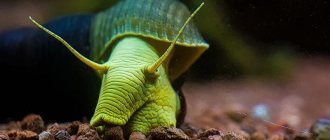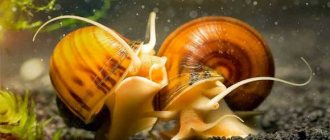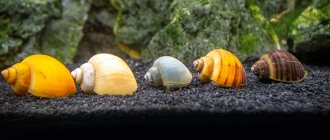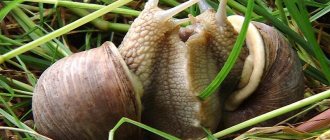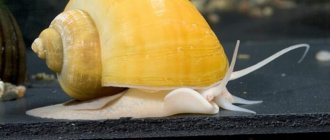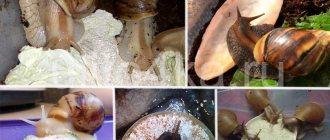Aquarium snail Ampularia
Possessing a unique ability to survive in the most unfavorable conditions and strong natural immunity, a significant part of the species of ancient gastropods has survived to this day. Ampularia is no exception; even now, despite its tropical origin, it has spread quite widely in the watery territories of many countries of the world with a warm or temperate climate.
It should be noted that Ampularia is not always a desirable neighbor of human civilization in its natural habitat. By growing excessively, some populations of this snail can cause significant harm to crop fields, primarily rice fields, which create especially comfortable conditions for the reproduction of ampullaria snails, which are not averse to feasting on the ripening harvest.
The Ampularia snail settled in aquariums at the beginning of the 20th century, in Germany, where it was brought by travelers from the wetlands of the Amazonian lowland located in Brazil, Bolivia, Peru, Ecuador and Colombia.
Ampularia is considered a fairly large snail for aquariums. In stores it is sold at a size of just over 2 centimeters in diameter and it is hard to believe that in about a year it can grow to 10 centimeters.
Not all types of ampullaria are equally suitable for living in home aquariums. Some of them reach sizes significantly exceeding 10 centimeters, which requires the creation of a special habitat for them.
The common aquarium snail Ampularia has a twisted shell, usually yellow or light brown in color with dark veins. Much less common are ampularia of almost white, blueberry and almost black color.
Ampularia's eyes are yellow-golden in color. The organs of touch are small tentacles, and an acute sense of smell contributes to orientation in space. This snail moves with the help of a muscular leg that has a protective flap, closing which the ampularia not only protects its vulnerable body, but also retains moisture during a period of prolonged drought or when outside the reservoir.
The ampularia is capable of breathing both under water and in the open air, but if it stays for a long time in only one of these environments, it can die - land.
In aquarium conditions, with proper care, Ampularia can live up to 3 years. In the wild up to 5 years.
Table of basic parameters of maintenance, care and nutrition:
| What should be the volume of an aquarium for aquarium snails? | from 10 liters |
| What should be the temperature in an aquarium for aquarium snails? | from +20-25° C |
| What pH should be in the aquarium? | from 6.5-7.8 pH |
| What should be the hardness of the water in the aquarium? | from 8-18° dH |
| What should be the substrate for an aquarium? | coarse or fine sand; soil size from 2-4 mm |
| What kind of lighting should be in the aquarium? | moderate |
| What should be the movement of water in the aquarium? | moderate |
| Maximum snail size | up to 10 cm |
| What do aquarium snails eat? | aquarium plants; food for fish; vegetables: cucumbers, zucchini, pumpkin, carrots |
| Type of aquarium snail | peaceful |
| Who is compatible with in an aquarium? | compatible with all peaceful aquarium inhabitants |
| Lifespan of aquarium snails | up to 3 years, but it depends on the conditions of detention |
Girl or boy?
Even if we agree that Achatina (or other types of land mollusks) are hermaphrodites, this does not mean that they can give birth without the participation of a second individual. Each snail has male and female reproductive organs. Therefore, mollusks are able to mate with each other. As a result, genetic material is transferred from one of them to the other.
In a “family” pair of snails, each of them has its own role. It has been noticed that the responsibilities of the female are taken over by larger and more mature mollusks. Accordingly, young Achatina, which are smaller in size, become males.
If it is decided to breed snails, and there is only one individual available, a pair is selected for it, based on the size and age of the partner. This way, it will be possible to know exactly what sex the snail is.
It also happens that two Achatina live in a home terrarium, but the pair of them does not form and there may be no offspring at all. Even bisexual mollusks are not always able to create a “family,” which must be taken into account when forming a pair.
But it also happens the other way around: each of the snails begins to lay eggs.
Achatina is a bisexual creature, so there’s no need to rack your brains about what name to call her. Each individual can have either a female or a male name. This will depend solely on the personal preferences of its owner.
Being in the same container, two mature individuals can lay clutches one faster than the other. As a result, a large number of newborn snails will be born. If the mollusks do not like each other, there may be no offspring at all.
Discussion
I also wrote about Achatina . These “animals” are very funny. And these snails laid eggs for me twice. However, there was no goal to breed large offspring, so I didn’t really follow it. The little ones hatched, and then I found empty tiny shells. What needs to be done to feed and raise Achatina offspring? + + +
Yes, I read. Good instructions. In general, it is better to freeze most of the masonry. Select 5-10-15... the largest eggs. They will be stronger than the smaller ones. You can, of course, leave the entire clutch, but then some of the eggs will be eaten or some of the hatched snails (weak). Therefore, they require a lot of territory, food and calcium. The clutch must be separated from its parents. In the same soil, just in a different tray. If you see that many snails are gnawing on one, it means that it is weak and will die anyway or there is no missing food. It’s better not to leave such weak ones - this is marriage. Babies are given calcium in the shell (not from boiled, but from raw eggs), but very crushed. The products are the same as for parents. But leafy ones (lettuce, grass) are cut, and hard ones (carrots, beets) are grated on a medium grater. And this is about 2 weeks. There must be a lot of calcium (sprinkle it on your food).
Thanks for the details! Just yesterday I discovered that my snail “laid” her testicles again. True, I accidentally dug up the masonry when I was loosening and moistening the soil. I only get calcium from raw eggs. And I also steam carrots and cabbage for an adult snail, I’ve probably spoiled it



